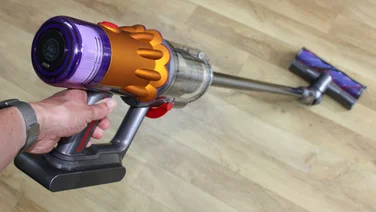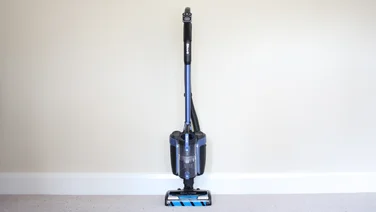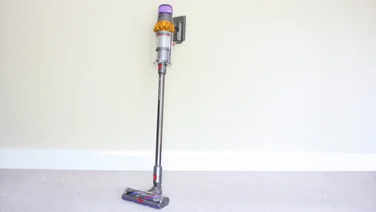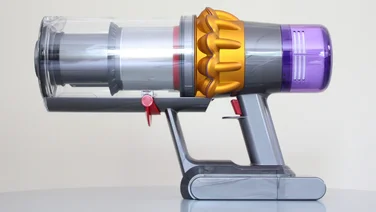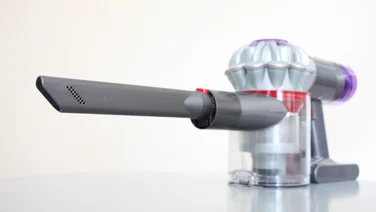To help us provide you with free impartial advice, we may earn a commission if you buy through links on our site. Learn more














- Excellent navigation
- Self-emptying
- Superb app
- Doesn’t spot obstacles
- Uninspiring mopping
- Falls short at edges
Robots such as the Roborock Q7 Max+, capable of vacuuming, mopping and self-emptying, tend to come with large docking stations. Roborocks design is a bit different, with a sleeker, slimmer docking station that doesnt have such a dramatic impact on the room you intend to keep it in.
The robot vacuum cleaner is still loaded with features, though. It has a rubber, brushless roller bar that minimises hair tangles, it uses LiDAR to sensibly navigate its way around your house, and it uses Roborocks excellent app to control where its allowed to go and how often it should clean.
Roborock Q7 Max+ review: What do you get for the money?
You could easily lose the Roborock Q7 Max+ in a room of robot vacuum cleaners, as it follows the increasingly standard pattern of a puck-shaped unit with a LiDAR turret sticking out of the top. It measures 350 x 353 x 97 mm (WDH) and weighs 3.8kg.
The self-cleaning base station measures 302 x 425 x 440mm (WDH) and has a large plastic base that the robot crawls onto when its finished cleaning. However, its overhanging collection unit is smaller than these dimensions might imply, as it doesnt take up the entire width of the base plate. This makes it look smaller than most rivals. It empties the robot from its base into 2.5l bags.














The underside of the robot is also a little different. Most robots use brushes on both the edge sweeper and the roller bar, but the Q7 Max has opted for rubber. The sweeper has five rubber prongs, which flick things from the edge of the room rather than sweeping them in more gently.
The roller bar uses rubber fins in an alternating arrangement of short stiff fins and longer softer fins, to agitate carpet. In our tests this significantly reduced the amount of tangled hair we encountered after cleans compared with traditional brush bars.
Inside the machine, the 470ml collection bin doubles up as a water tank with a capacity of 350ml, so you dont need to swap bins if you decide to use the mopping feature. However, the mop function does require that you attach a mop plate to the underneath of the vacuum. You can slide it on and off while the robot is parked on its dock, and Roborock suggests you remove it from the robot when its not mopping.READ NEXT: The best budget cordless vacuum cleaners to buy
Roborock Q7 Max+ review: What is it like to use?
As with the vast majority of robot vacuum cleaners, the Roborock Q7 Max is controlled using a smartphone app, available for Android and iOS. You can either download Roborocks own, or integrate the cleaner with the Xiaomi Home app.
We tested the Roborock version and found it excellent. The app is well designed, easy to use, and crammed with tools and features. At a basic level, you can open the app and set the vacuum off on a mission to clean everything it can reach at the touch of a button.














The first time it goes out, you can choose whether it performs a clean or makes a mapping run to build up an idea of where it needs to go in the future. Id recommend the latter, because it doesnt take long (around eight minutes for my 61m2 ground floor) and you can only make changes to the map when the vacuum is paused or parked.
It might miss a dark corner or two, but by the time its finished there will be enough of the map filled in for you to start adding no-go areas and virtual walls. These are used to stop the robot from entering rooms you want to leave alone or avoid permanent hazards such as cable nests and pet food bowls.














Once the map is completed, the app attempts to divide it into rooms automatically, so you can easily choose where the robot will go in the future. You can either opt for a full clean of the whole area, choose one or more individual rooms, or draw an area on the map, which the robot will head to and clean. If the app doesnt subdivide your rooms correctly, you can edit the map manually.
Thats not all you can do with the app, though. You can also set up scheduled cleans and create routines for particular jobs, such as cleaning up after meal times. And you can adjust the suction strength and how much water the mop uses.














If theres one thing robot vacuum apps can get wrong, its the management of different maps for multi-storey houses. Roborock doesnt fall into the same trap, instead proudly announcing it can juggle up to four maps when you first switch it on. That should be enough for most homes.
Setting up maps is simple. You simply choose to create a new map when you move it to a new location. Once the map is created, the robot performs a scan of its environment before it starts, and opens up the correct map automatically. Its a virtuoso performance.
As well as using the app, you can connect the device to your Amazon or Google smart home devices. I tested it on my Google Home setup and it integrated well with the Roborock app. As well as simply starting and stopping the robot, its possible to verbally command it to do certain things youve set up, such as clean specific rooms or named areas.
Roborock Q7 Max+ review: Is it good at finding its way around?
Nothing fazes the Roborock Q7 Max when it comes to find its way around. In my tests, it deftly climbed doormats and door sills that have caused problems for rivals. It found its way between the dock and distant locations using sensible, efficient routes, without needing to follow walls. It also handled traps well, rarely getting caught in the legs of troublesome tables.
It isnt the gentlest of robots around furniture legs, but it usually slows before bumping into such things. Once its detected a leg by nudging it, it gives it a relatively wide berth.
It shouldnt damage your furniture or get stuck, then, but does mean the edge sweeper wont always get as close as you might expect. Its similarly gentle around walls and skirting boards, which it only touches lightly before turning and following them.














I could criticise certain other elements of the navigation, such as how far it let the base of the robot travel under my coffee table before turning away so the LiDAR turret doesnt crash into it, but Id be splitting hairs. The headline here is that this is one of the best robots Ive seen at navigation.
The one thing it doesnt do, as the iRobot Roomba j7 can, is avoid random objects. As a result, the Q7 Max is best left to operate on a clear floor. If you live in a household that struggles to keep the floor free of clutter, the Roomba j7 will offer greater peace of mind.READ NEXT: The best robot mops to buy
Roborock Q7 Max+ review: How well does it clean?
I tested the Roborock Q7 Max+ by running it through our usual barrage of cleaning tests. I started with a 50g spillage of rice on hard floor. Robots are usually fairly good at picking up rice, as long as their edge brushes dont get a chance to scatter it outside the area theyre cleaning before its had a chance to be vacuumed.
The cleaning pattern the Roborock takes for a spot clean isnt terrible but Ive seen better. I used the app to square off an area that contained the spill and the robot made its way to the closest edge. It then circled the perimeter of the area with the edge brush on the outside, which is good as it ensures dirt particles are swept from the outside in.














However, once it completed a circuit, it used the usual perpendicular lines approach to cover the area and collect the rice. Personally, I prefer the concentric circle taken by the AEG RX9.2. Perhaps more by luck than judgement, or because the rubber edge sweeper is adjusted not to fire every speck it touches out of the park, there was remarkably little scatter. As a result, the Roborock collected 49g out of 50g, which is a solid result.
On short-pile carpet I saw exactly the same result of 49g. The remaining 1g of rice was scattered out of reach, but it was still an impressive performance.














Flour is a tougher ask, usually because robots roll their wheels through flour spillage before having a chance to pick it up. Also, their vacuum inlets arent usually as well sealed to the floor as with a traditional vacuum, because they need some clearance to avoid getting stuck on obstacles.
In our tests, the Roborock collected 38g of a 50g carpet spillage and 36g from hard floor. This is a fair bit to leave behind, and the usual problem of rolling through the flour and spreading it around on the wheels was evident.

However, its variable suction must have made a difference in the carpet test, where it bettered most other robots weve tested in recent months. The robot detects whether its on carpet or hard floor, and audibly cranks up the suction when it needs to. Id guess thats what happened here, with the more powerful suction simply pulling more powder from the spillage. However, there was still a lot of flour to clean up after a single pass on both surfaces.
The one element of a clean that lets the Roborock Q7 Max+ down is the short reach of its edge brush. In my kitchen, for example, crumbs and other bits regularly get shoved to the kick boards. Most robots use their edge sweepers to attempt to flick such detritus out, but the Roborock either doesnt get close enough or is simply not good enough to catch and flick such bits out. This wasnt just a problem with the odd crumb, it routinely failed to dislodge loose scattered items if they were too close to a wall.
When it comes to mopping, the robot follows a fairly standard pattern of not being particularly brilliant. Most robot mops of this price simply drag a damp cloth around behind them, and the Roborock is no different. Its a gentle clean, which leaves a trace of water behind, although its a small enough amount to dry rapidly. As youd imagine it might pick up a light spill thats fairly loose or still damp, but it isnt going to scrub off a dried-on stain.
Unfortunately, despite managing to increase the suction when its on carpet, it cant stop mopping. As a result, if youve got the mop attached, you need to make sure the robot doesnt cross any carpet. You can set it to clean rooms and areas when mopping and ignore any carpets that way, but you have to do that manually. Roborock also suggests you dont leave the mop attached when its not in use.
Roborock Q7 Max+ review: Should I buy it?
The Roborock Q7 Max+ is one of the most complete robot vacuuming packages Ive seen. The robot itself is a decent cleaner, excelling in many if not all areas. The app is top tier, the navigation and mapping is superb, and most criticisms you can level at the device are minor niggles rather than significant problems as long as you dont expect too much of the mop. It performed well in our tests, and the self-emptying charging station works a treat.
If you want to schedule regular cleans and cant guarantee that you wont leave things on the floor, opt for the iRobot Roomba j7 instead. This costs £799, almost twice the price, and goes up to £899 if you want it with the optional self-emptying charging station. But its worth the peace of mind if youre not sure how tidy you can keep things.
For a better-performing mop, you need to travel further up the price scale to escape the models that simply drag a cloth behind them. The Ecovacs Deebot X1 Omni (usually around £899) would be our pick here, because it has rotating mopping pads that deliver a far more thorough clean. Its large docking station holds clean and dirty water to mop and rinse through its pads, and it also self-empties into convenient bags.


